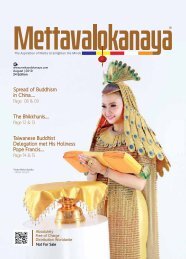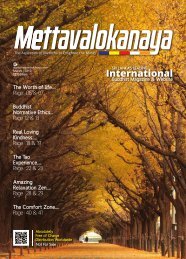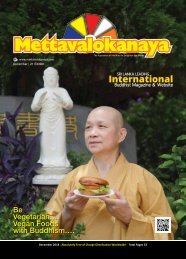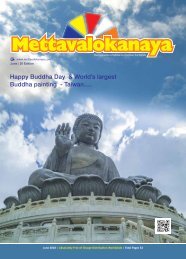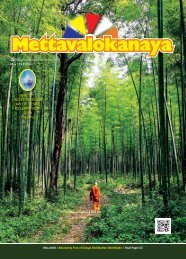mettavalokanaya_international_buddhist_magazine_november_2019
This is the Sri Lankan's Most Popular & Leading Monthly International Buddhist Magazine, “Mettavalokanaya” on November Edition - 26. “Mettavalokanaya” Buddhist Magazine has been successfully distributed to 40 countries including all districts across Sri Lanka and distribute to all Overseas Chief Sangha Nayaka Theros, Worldwide Buddhist Associations, High Commissions & Embassies situated in Sri Lanka & overseas Sri Lankan High Commissions & Embassies.
This is the Sri Lankan's Most Popular & Leading Monthly International Buddhist Magazine, “Mettavalokanaya” on November Edition - 26. “Mettavalokanaya” Buddhist Magazine has been successfully distributed to 40 countries including all districts across Sri Lanka and distribute to all Overseas Chief Sangha Nayaka Theros, Worldwide Buddhist Associations, High Commissions & Embassies situated in Sri Lanka & overseas Sri Lankan High Commissions & Embassies.
Create successful ePaper yourself
Turn your PDF publications into a flip-book with our unique Google optimized e-Paper software.
“Buddha’s
Teachings
greatness still
shines today”….
Buddhism recognizes two kinds of
Truth, the apparent conventional
truth concerning mundane
matters and the real or ultimate
Truth concerning the supramundane.
The ultimate Truth can be realized
only by developing the mind through
meditation, and not by theorizing or
speculation.
The Buddha’s Teaching is about
the Ultimate Truth regarding the world.
Buddhism, however, is not a revealed
or an organized religion. It is the first
example of the purely scientific approach
applied to questions concerning the
ultimate nature of existence. This
timeless Teaching was discovered by
the Buddha Himself without the help of
any divine agency. This same teaching
is strong enough to face any challenge
without changing the basic principles
of the doctrine. Any religion that is
forced to change or adjust its original
The Chief Incumbent of
Buddhist Maha Vihara,
Brickfields Kuala Lumpur,
Malaysia
Most Venerable Datuk
Kirinde Dhammaratana
Nayaka Maha Thero
Malaysia
The
Ultimate
Truth….
Teachings to suit the modern world, is
a religion that has no firm foundation
and no ultimate truth in it. Buddhism
can maintain the Truth of the original
Teaching of the Master even under the
difficult conditions prevailing in the
modern world. It can face any challenge
posed by the most rigorous method of
scientific inquiry. The Buddha did not
introduce certain personal or worldly
practices which have no connection with
morality or religious observances. To the
Buddha, such practices have no religious
value. We must make the distinction
between what the Buddha taught and
what people preach and practice in the
name of Buddhism.
Every religion consists of not only
the teachings of the founder of that
religion but also the rites and ceremonies
which have grown up around the basic
core of the teachings. These rituals
and ceremonies have their origins in
the cultural practices of the people
who accepted the religion. Usually the
founders of the great religions do not lay
down precise rules about the rituals to
be observed. But religious leaders who
come after them formalize the religion
and set up exacting codes of behavior
which the followers are not allowed to
deviate from. As we discussed earlier,
this is one of the reasons why the Buddha
did not appoint a successor.
Even the religion which we call
‘Buddhism’ today is very different in its
external practices from what the Buddha
and His early followers carried out.
Centuries of cultural and environmental
influence have made the Myanmar,
Thai, Chinese, Tibetan, Sri Lankan,
Japanese and Korean Buddhist way of
life different. But these practices are not
in conflict, because the Buddha taught
that while the Truth remains absolute,
the physical manifestation of this truth
can differ according to the way of life of
those who profess it. Thus, the modern
religion we see in many countries is the
product of normal human beings living in
a country and adjusting to various social
and cultural environments. However,
Buddhism as a religion did not begin as
a super-worldly system that came down
from heaven.
Rather it was born and evolved
through a long historical process. In its
process of evolution, many people slowly
moved away from the original Teachings
of the founder and started different
new schools or sects. All the other
existing religions also face the same
situation. A few hundred years after
His passing away, the disciples of the
Buddha organized a religion around the
Teachings of the Master. While organizing
the religion, they incorporated, among
other concepts and beliefs, various types
of miracles, mysticism, fortunetelling,
charms, talismans, mantras, prayers
and many rites and rituals that were not
found in the original Teaching. When
these extraneous religious beliefs and
practices were introduced, many people
neglected to develop the most important
practices found in the original Teaching:
self-discipline, self-restraint, cultivation
of morality and spiritual development.
Instead of practicing the original Teaching,
they gave more of their attention and
effort to protection from evil spirits and
became more interested in discovering
ways and means of getting rid of the
so-called misfortunes or bad influences
of stars, black magic, and sickness. In
this manner, through time the religious
practices and beliefs degenerated, being
confined to worldly pursuits. Even today,
many people believe that they can
get rid of their difficulties through the
influence of external powers. People still
cling to these beliefs. Hence they neglect
to cultivate the strength of their willpower,
intelligence, understanding and
other related humane qualities. In other
words, people started to abuse their
human intelligence by following those
beliefs and practices in the name of
Buddhism. They also polluted the purity
of the sublime teaching of the Buddha.
One should therefore not come
to a hasty conclusion either to judge
the validity of a religion or to condemn
it simply by observing what people
perform in the name of that religion.
To understand and evaluate the real
nature of a religion one must study and
investigate the original Teachings of the
founder of that religion. In the face of the
profusion of ideas and practices which
were later developments, it is useful for
us to return to the positive and timeless
Dharma taught by the Buddha. Whatever
people believe and practice in the name
of Buddhism, the basic Teachings of the
Buddha still exist in the original Buddhist
texts.
Buddhism is one of the oldest
religions still being practiced in the world
today. While the names of many other
religions which existed in India have
been forgotten, the teachings of the
Buddha, (better known as the Dharma)
are still relevant to the needs of today’s
society. This is because the Buddha
always considered Himself as a human
religious teacher whose message was
meant to promote freedom, happiness
and wellbeing of others. The Buddha’s
primary concern was to help His followers
to live a normal life without going to the
extremes of either self-denial or totally
surrendering to sensual desires.
The practical nature of the
Buddha’s teaching is revealed in the
fact that not everyone is expected to
attain exactly the same goal in one
lifetime, since the mental impurities are
rooted differently in individuals. Some
people are spiritually more advanced
than others and they can proceed to
greater heights according to their state
of development. But every single human
being has the ultimate potential to attain
the supreme goal of Buddhahood if he or
she has the determination and will to do
so.
Even now does the soothing,
sweet voice of the Buddha ring in our
ears. And sometimes we perhaps feel
a little ashamed because we do not
understand Him fully. Often, we only
praise His Teaching and respect Him, but
do not try to practice what He preached.
The Buddha’s Teaching and message
have had their effect on all people for
thousands of years whether they believe
in any religion or not.
His message is for all. Though the
Buddha, the flower of mankind, is no
longer in this world, the sweet fragrance
and exquisite aroma of His Teachings
have spread far and wide. Its balmy,
diffusing fragrance has calmed and
soothed millions. Its ambrosial perfume
has heartened and cheered every nation
which it has penetrated. The reason that
His Teachings have captured millions of
hearts is because they were introduced
not by weapons or political power but
by love and compassion for humanity.
Not a drop of blood stains its pure path.
Buddhism wins by the warm touch of
love, not by the cold claws of fear. Fear
of the supernatural and the doctrine
of everlasting hell-fire have no place in
Buddhism.
During the last 25 centuries since
the appearance of the Buddha, many
changes have taken place in this world.
Kingdoms have risen and fallen; nations
have prospered and perished. And the
world today has forgotten many of these
past civilizations. But the name of the
Buddha remains alive and fresh in the
minds of millions of people today. The
Kingdom of Righteousness that He built
is still strong and steady. Although many
temples, pagodas, images, libraries
and other religious symbols erected in
His honor were destroyed by religious
fanatics from time to time, His untainted
Noble Name and the message He gave
remain in the minds of understanding
people.
Tribute to Most Venerable Dr.
Kirinde Sri Dhammananda Maha Thero.
16 l Mettavalokanaya l November l 2019 l www.mettavalokanaya.com www.mettavalokanaya.com l 2019 l November l Mettavalokanaya l 17











